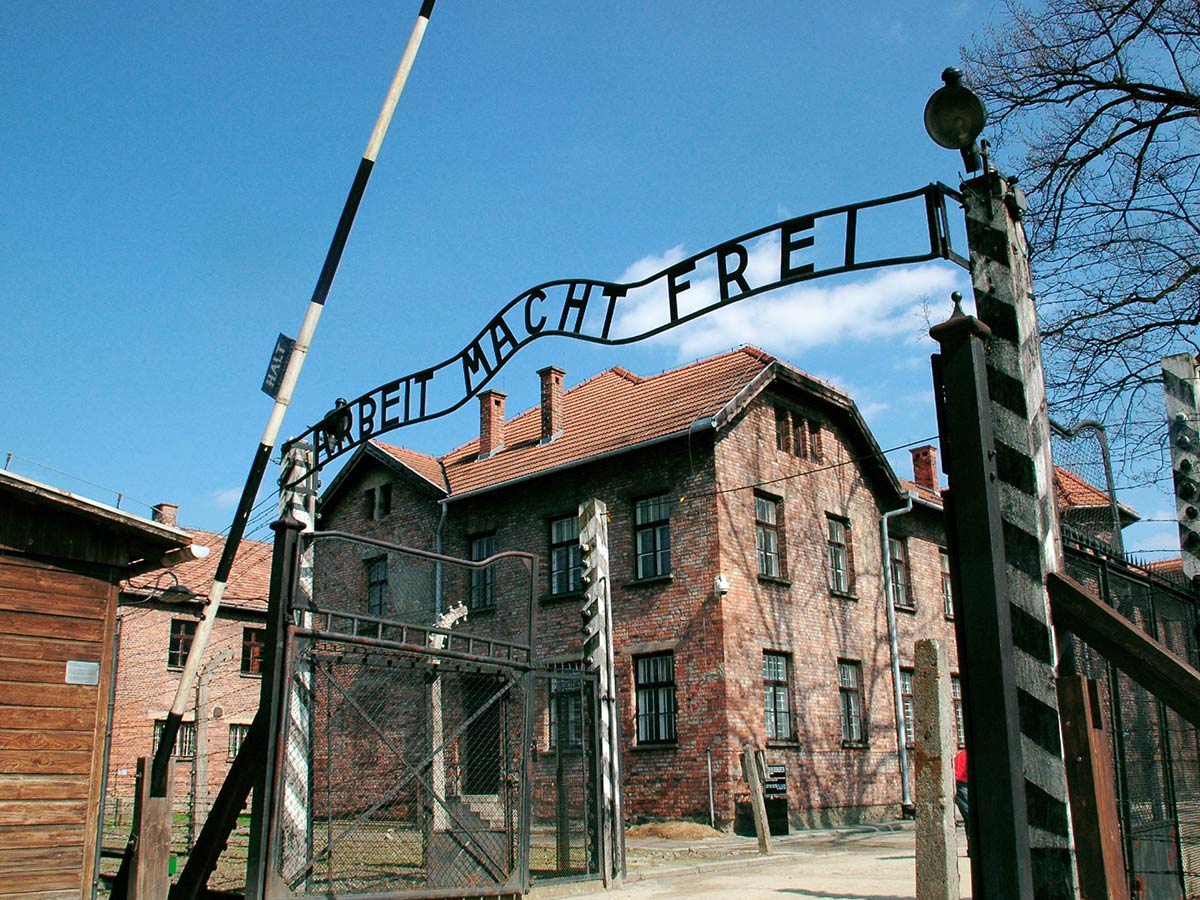
While The Food Quest is a travel blog focused on the culinary culture of the places I visit, every now and then I find myself a part of a gripping travel experience that doesn’t involve food. In those instances I can’t, in good conscience, leave out those experiences from a travel blog. Rarely, but occasionally, I’d like to share my unique not-food-focused travel experiences with my readers.
Since tomorrow, January 27, 2020, marks the 75th Anniversary of the liberation of the Auschwitz extermination camp, I find it imperative to share my experience during a trip to Poland in 2010.
My visit to Poland, especially to the death camp, left such a deep impression that each year since visiting I’ve found it necessary to think about the survivors and look back at some of the photographs I took during my visit.
While I understand many have visited Auschwitz, a present-day museum, to pay their respects I find my personal experience in Poland quite unique.
Devastation, Past and Present
In college I studied abroad in Prague and I used the weekends to take advantage of Europe’s cheap travel options to visit other countries. Many students did that same, but it became apparent half way through the semester that many students reserved Poland as a traveler’s right-of-passage. Yes, it had night clubs, bars, a lively young social scene. But it also had Auschwitz. And for at least one day of your trip, all your distant middle school learning would come to a horrifying reality. And you were frozen. And that night wasn’t clubbing night. It was a reflecting night. One where you blankly stare into your wine glass while visions of standing cells and the “death wall” made you feel queasy.
Part of me dreaded and part of me looked forward to my trip to Krakow, Poland because I was so morbidly curious. For years in school I learned about concentration camps, World War II, Hitler, brutal torture and deaths. I wondered what it would be like to see the camp’s remains in person. It’d be so real. So haunting.
I pushed the trip off until the end of my study abroad program and planned to make the trip in April.
Five days before boarding a midnight train to Krakow, an unthinkable tragedy occurred in Poland that stunned the world.
A Polish plane carrying several high-ranking government and military officials, including Poland’s President and his wife crashed in Russia. There were no survivors. All 96 lives onboard perished. In what would later become known as the Smolensk Air Disaster, the catastrophe utterly shocked the entire Polish nation along with the rest of the world. A week-long state of mourning was declared by a shaken, now acting President.
A Midnight Train to Krakow
My traveling companions and I decided to keep our plans to visit the nation. I was a journalism student who had been taking courses in International Reporting, Travel Writing and History of Eastern Europe. I wasn’t looking for a vacation to lounge and kick my feet up. That’s not why I had made plans to visit Poland. I was curious. And when the plane crash happened, I was shocked and saddened. But the budding journalist in me was hungry for information. In the same morbid way I wanted to understand what the infamous Auschwitz was actually like, I wanted to understand – first hand – what the Poles were going through.
In the middle of the night (cheapest ticket, student budget) we boarded what seemed to be a Soviet-era train. Our reserved cabin was decked out in red velvet with a window that could slide open. The ceilings of the train were tall, which we realized later, allowed for three-tiered bunk beds as opposed to the traditional two.
I took the middle bunk, which put me eye-level with the window. I laid on my bed and looked out the dark window and tried to make out the shapes of the landscape. I couldn’t help but wonder what the next few days would be like.
Arriving a City in Mourning
We arrived Krakow – a small picturesque southern city – early and walked through a deserted town in dense morning fog to our hostel.
By the late morning we were rested and prepared to explore Krakow. The townspeople seemed hard at work setting out candles in the streets, hanging poster-sized pictures of the victims on building facades and tying black ribbons to their red and white national flag.
Bars, restaurants and museums were mostly closed except for a few places here and there. Street vendors and little cafes seemed to be the best places to find authentic Polish foods. We spent the afternoon familiarizing ourselves with the city and its happenings. In the evening we stumbled into a small hole-in-the-wall restaurant that was open and serving an older group of sulking men mugs of vodka.
We took a seat in the back and after a day spent witnessing sadness, we needed a drink too. Only, we opted for beer. I ordered borscht, their homemade beet soup, and it was served in a big mug. The restaurant was quiet and out of respect, so were my companions and I.
Often times when a group of American college-aged students arrive at a restaurant, a bunch of eye rolling starts. Young American adults have earned themselves the reputation in Europe of being the epitome of obnoxious guests. They’re typically looking to get drunk, because they’re not yet 21 and drinking legally is a new novelty for them in Europe. When we arrived at the restaurant, we were met with the same glare from the older European men – a look that said to us: ugh not today. But I had been lucky enough to travel with courteous, considerate and polite companions.
So we slurped our beer and we slurped our soup and did what we could to be break with the stereotype.
Auschwitz – Beyond the Barbed Wire
As if our first day hadn’t already brought about a heavy dose of reality, on day two we boarded a bus that took us about 30 miles west of Krakow to World War II’s largest and deadliest concentration camp – the most infamous camp of them all, Auschwitz.
The 15-square-mile land is where 1.1 million souls perished under the iron force of Adolf Hitler.
When Auschwitz first opened, it originally consisted of 20 brick buildings which were former Polish Army barracks known as “Blocks.” Auschwitz received its first prisoners – about 30 men – in spring of 1940.
The majority of the Blocks housed inmates and some Blocks were used as places of torture. Other Blocks were administration buildings, the Headquarters and an inmate reception centered where incoming prisoners were given uniforms, their heads were shaved, and their arms tattooed with a number.
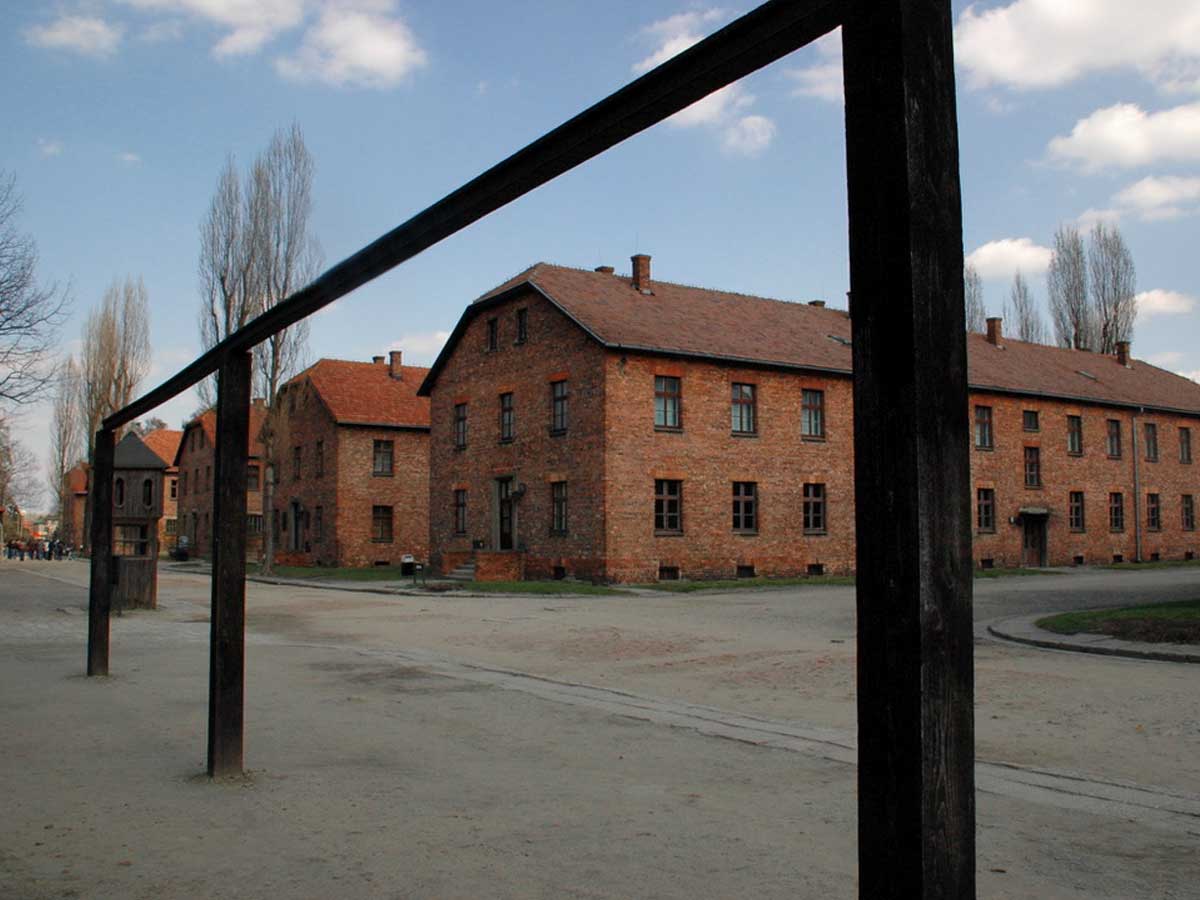
After the first 30 inmates arrived, prisoners began arriving by the hundreds and were forced to live in squalid conditions. Each Block was designed to hold about 700 people, but roughly 1200 people were forced to live in each building. Prisoners had no beds or furniture and slept on straw. Inmates were forced to build second stories on most of the original buildings to expand the amount of space in order to receive more prisoners.
Block 11 at Auschwitz
Auschwitz quickly earned a reputation for its brutality due to its torture practices. Block 11, dubbed the Death Block was a collection of torture chambers housed under one roof. It’s where some of the most twisted and nauseating torture took place at Auschwitz. Entering felt like crossing the threshold into a small piece of Hell on Earth.
“Standing Cells” in the basement of Block 11 were exactly that – tight cells too small to sit down in forcing the victim to stand. Each cell was 1 square meter (about 3ft by 3 ft) where 4 people were made to enter and stand for several days as a form of torture. Standing pushed up against strangers for sometimes as long as 20 days, each cell consisted of only one 5cm hole for breathing.
I could barely look inside the cell to imagine what that must have looked like. I felt queasy and had a cold sweat trying to imagine what must have been happening in the minds and bodies of these poor souls. A true psychological and physical terror.
Outside and to the left of Block 11 is a small courtyard. At the back of the courtyard I saw a small candlelit memorial set up in front of a brick wall. Initially I thought it was a little tribute to the victims of the plane crash, but our tour guide quickly explained we were looking another gruesome spot – the Death Wall. Along this wall prisoners were lined up and used as target practice for the Schutzstaffel – commonly known as the SS – a military-like group enforcing Nazi security, surveillance, and terror.
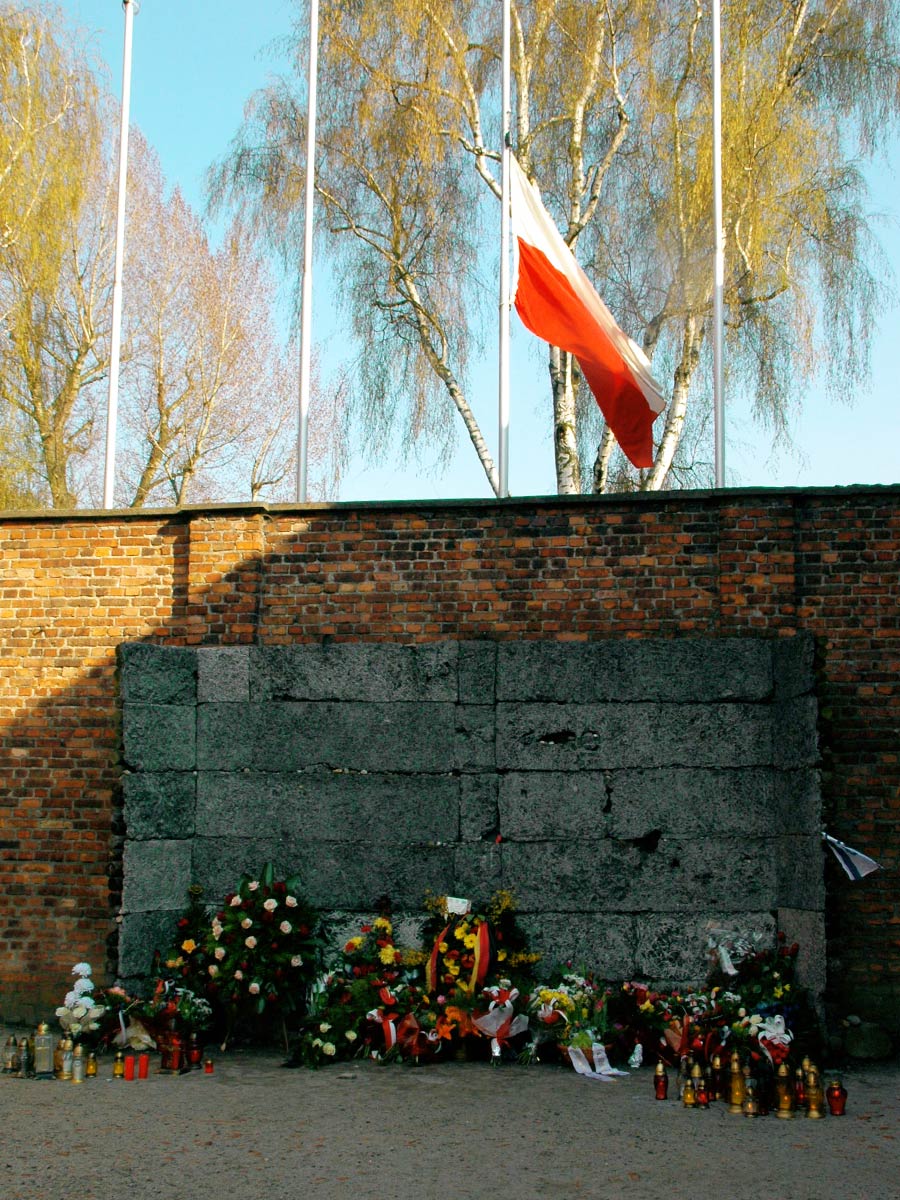
The first “gassing” experiment with Zyklon B crystals – took place in the basement of Block 11 a little over a year after Auschwitz opened. After the disgusting success of the experiment, and several more experiments, the morgue was turned into a gas chamber which could hold about 750 lives at a time.
The infamous mass crematoriums at Auschwitz had originally started as one small one to rid bodies of those that had perished of illness or execution. It was not intended to act as a tool to quickly get rid of a mass number of bodies. Crematorium 1, as the original crematorium was called, could destroy about 340 bodies in 24 hours. However, once the mass gas chambers were built, three more crematories were built eventually allowing for the cremating of 5,000 bodies in just under 24 hours.
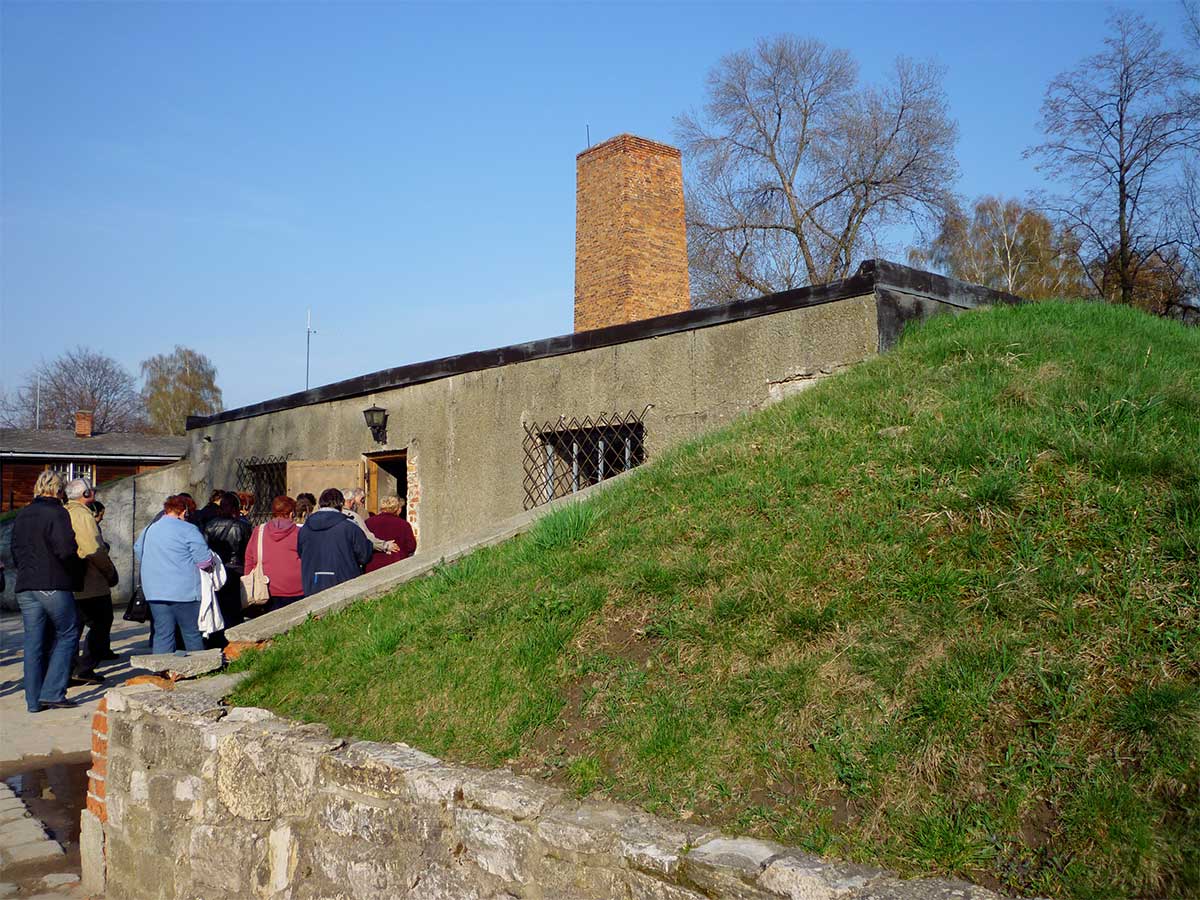
Our tour group visited Crematorium 1 and our guide let us know if, once inside, it was too much for someone to handle, they were free to immediately step back outside. The steps we took into the crematorium were surreal, unbelievable, heartbreaking… haunting. Our group varied in age and one older couple dabbed their eyes. Everyone seemed choked up. Everyone was quiet. What I wasn’t prepared for, were the nail marks scratched into the walls.
We were told that part of this crematorium was reconstructed, but some of the original walls weren’t repainted. And although through the years, many tour groups have been able to touch the walls, there are still clear nail marks that almost reach the ceiling. I couldn’t focus on much else while inside – my focus was set on one wall where prisoners clawed at cement walls for their lives. 10 years later, when I think back to my experience at Auschwitz, this is the memory from that day that still sends shivers down my spine.
Auschwitz Expands and builds Auschwitz II – Birkneau
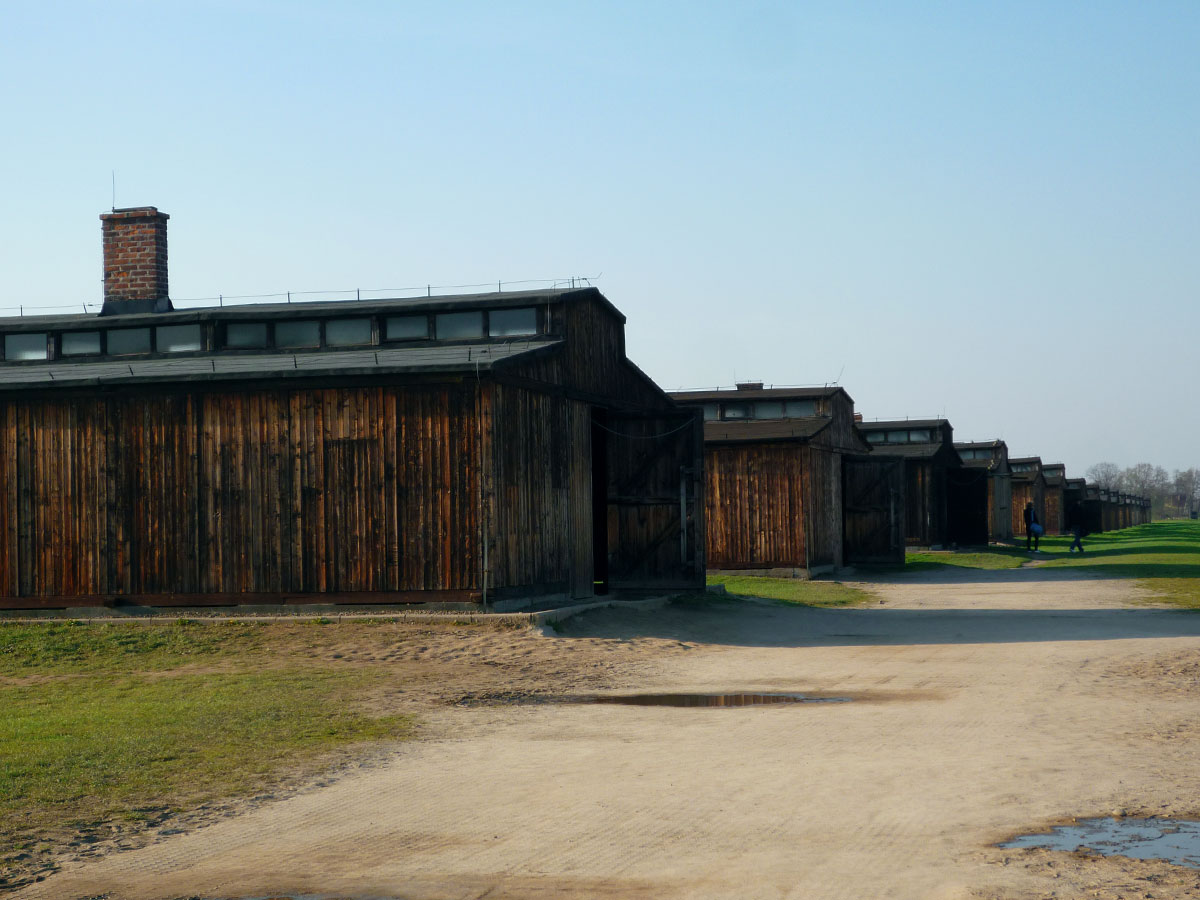
As Auschwitz received more prisoners, the decision was made to expand the camp. Birkneau, set less than 2 miles down the road was a roughly 420-acre expansion, dubbed Auschwitz II. This hell would become the deadliest place in the Auschwitz compound since it eventually used a group of gassing chambers. Birkneau is where 90% – about 1 million – of the imprisoned victims at the camp would perish.
Holocaust scholar Robert Jan van Pelt described the living situation at Birkneau: “There were 174 barracks, each measuring [116 by 36 ft], divided into 62 bays of [43 sq ft]. The bays were divided into “roosts,” initially for three inmates and later for four. With personal space of [11 sq ft] to sleep and place whatever belongings they had, inmates were deprived of the minimum space needed to exist.”
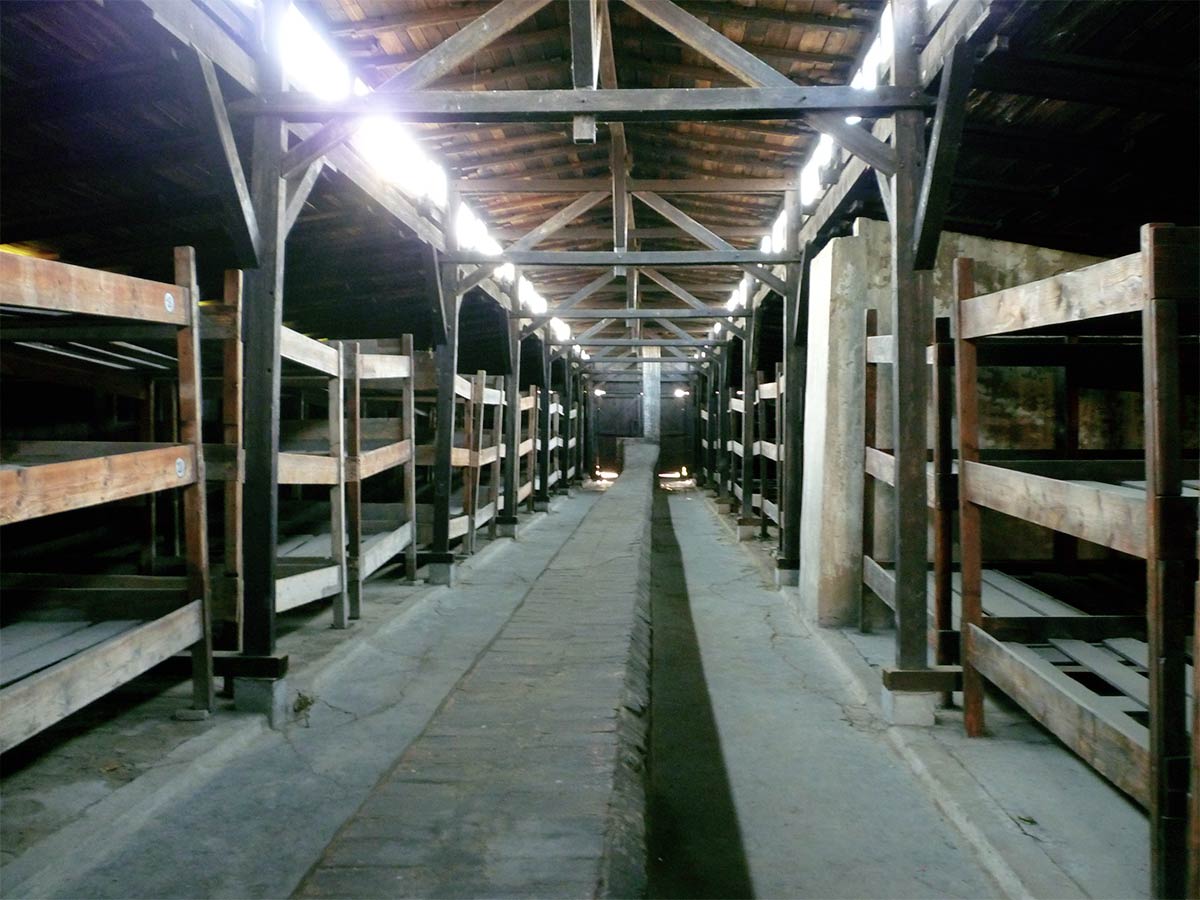
These wooden barracks with no insulation looked out over barbed wires, watch towers, the train tracks that lead them there and the Death Gate.
The Death Gate
Where the train tracks come to an end, there stands the Death Gate. Looming over the “sorting” ground, where families were ripped apart as they stepped out of gruesome train cars, the Death Gate and train tracks is one of the most recognizable places at Auschwitz.
Former tracks with memorial candles and flowers set up, it’s a place for visitors to pay their respects to the victims. A lifeless place that, even on the most beautiful spring day, is somber. I found it really difficult to stand at the mouth of the gate and follow the tracks into the distance, knowing those that arrived in the spot I was standing thought the worst of it – arriving in cattle cars – would be the end of their misery.
Encompassed by barbed wire and watchtowers, it’s as if the grounds itself are haunted. The place where families were broken up into lines. People thinking they’d see their loved ones later. Not yet understanding what it meant to be assigned to the right line or the left line – one to the labor camps one to the gas chamber.
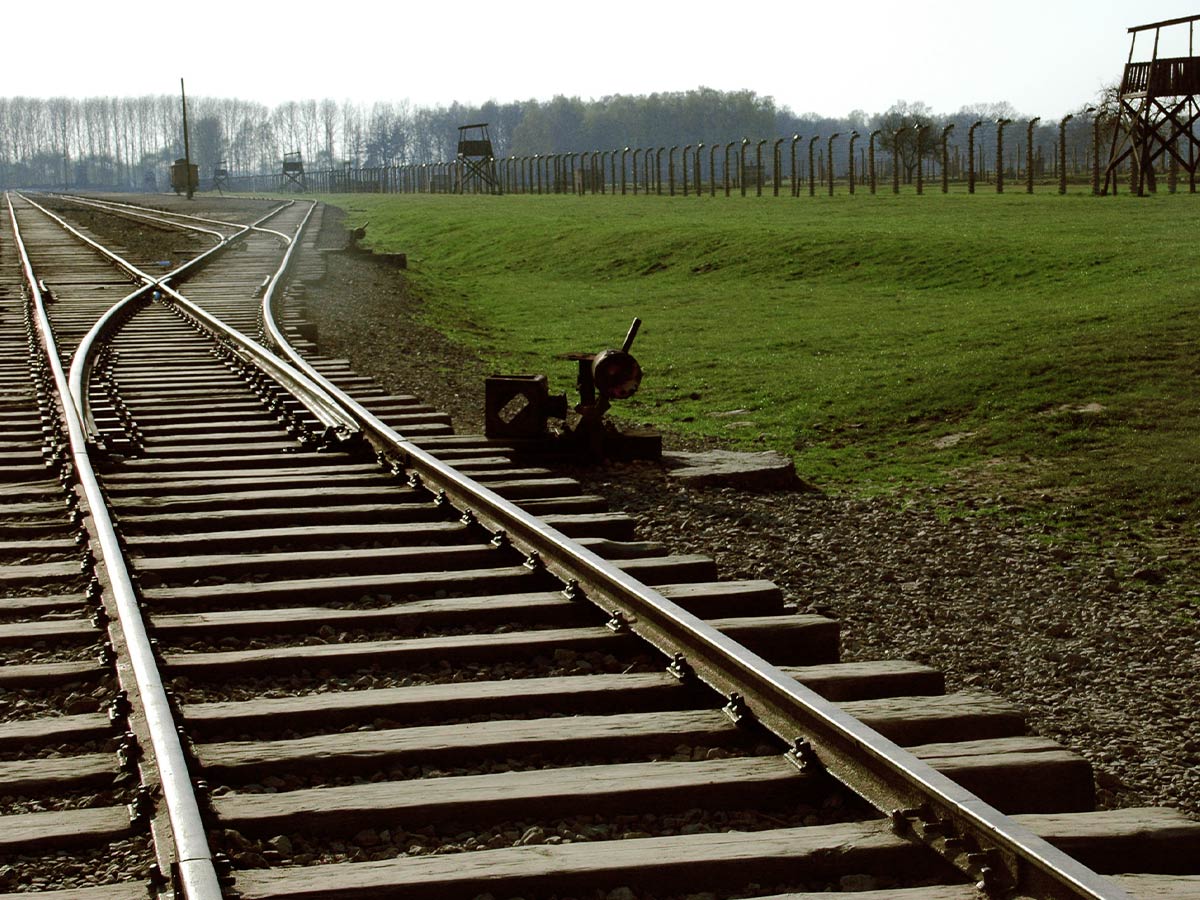
This place, on the train tracks, in front of the Death Gate was the site where millions of emotions poured into the ground below and still rise to the surface to haunt visitors today. This place was the prelude of all the grief and misery – a place of mass confusion, shock, anger – mothers and fathers trying to hold on to their children and each other.
Silent Reflection
The bus back from Auschwitz to Krakow was a silent one. I’m not sure why, but I always imaged that Auschwitz was in the middle of nowhere. I expected to travel at least an hour by bus down narrow roads until a view of barbed wires came into view. But that wasn’t the case.
Five minutes down the street from the Auschwitz gates stood a McDonalds, apartment buildings and shopping centers. I had never heard of the small Polish town of Oswiecim because people only refer to it by its German name, Auschwitz.
But Oswiecim is a town, a community, where people live in the shadows of its evil past. Some locals will always harbor a resentment, not only for what the Nazis did to their people, but also for what the Nazis did to Oswiecim’s 800 years of history. Now, generations of families live with the black mark of late 1930s into the mid 1940s – and all other details of the town seem like a moot point.
Regardless, some weave Oswiecim’s dark reputation into their family’s unique narrative.
We often think about the prisoners uprooted from their homes across Europe and brought to Auschwitz, but we rarely think about what it must have been like for your hometown to be turned into a place where over one million people came to die. These locals offer an often overlooked, very personal perspective of fear, silence, heroism, devastation and the search for peace.
After returning to Krakow that evening, I didn’t take any “food pictures.” I just remember sipping a glass of white wine at a small, dark bar. We joined other patrons in again keeping quiet while they mourned their President, and we mourned their past.
A New Day of Mourning

Not having been old enough to experience President Kennedy’s assassination, I had no idea what to expect from a country who had just lost their leader.
It was Sunday April 18, 2010; the final day of national mourning for the victims of the plane crash. The funeral, taking place in Warsaw, would be live-streamed via giant TV monitors in city squares throughout Poland.
My fellow travelers and I woke early to walk the cobbled streets to find some coffee and pierogies before heading to Krakow’s Main Square.
A demand for Answers
President Lech Kaczyńsk, his wife Maria, Polish military officers, the President of the Polish National Bank and relatives of the victims of the Katyn Massacre were enroute from Warsaw to an airport in Smolensk, Russia to attend a memorial service to commemorate the 70th Anniversary of the Katyn Massacre – where 22,000 Polish military, intellectuals, priests and rabbis were murdered and buried in mass graves.
Russia originally blamed these brutal killings and mass graves on the Nazis. Then in 1990s Russia changed their story, admitted responsibility and condemned NKDV – the Soviet-era secret police for the brutal killings of so many brilliant Polish minds and leaders. The Katyn Massacre was named after the Katyn Forest where some, but not all, of the mass graves were found.
During the flight’s descent, dense fog obscured the landing, causing the plane to catch the tops of trees, causing the flight to roll and crash into a wooded area a short distance from the runway.
Although international investigations did not find evidence to support his theory, Jaroslaw Kaczynski – twin brother to President Lech Kaczyński – claiming the crash was a political assassination.
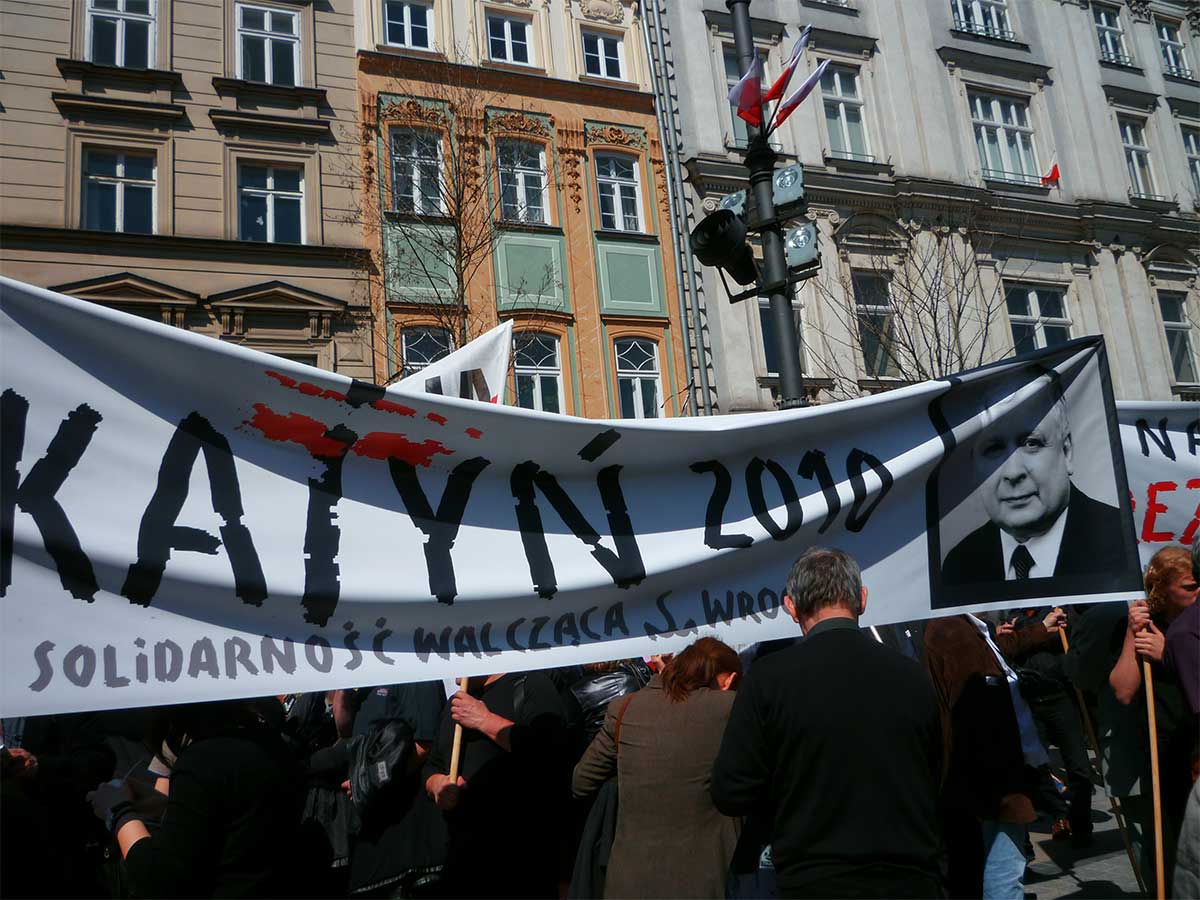
Along with sadness, the crowds gathered for the funeral were angry and wanted to know why the crash happened and who was to blame.
As we neared the Main Square, we noticed all the locals dressed in somber black or bright red and white patriotic gear. People walked through the streets as families, as lovers, as friends and alone. Many walked the streets waving Polish flags and set in every nook and cranny of the prewar buildings were pictures of the victims. Candles and flowers – some strewn about, some creatively organized – left the small streets filled with an amber glow.
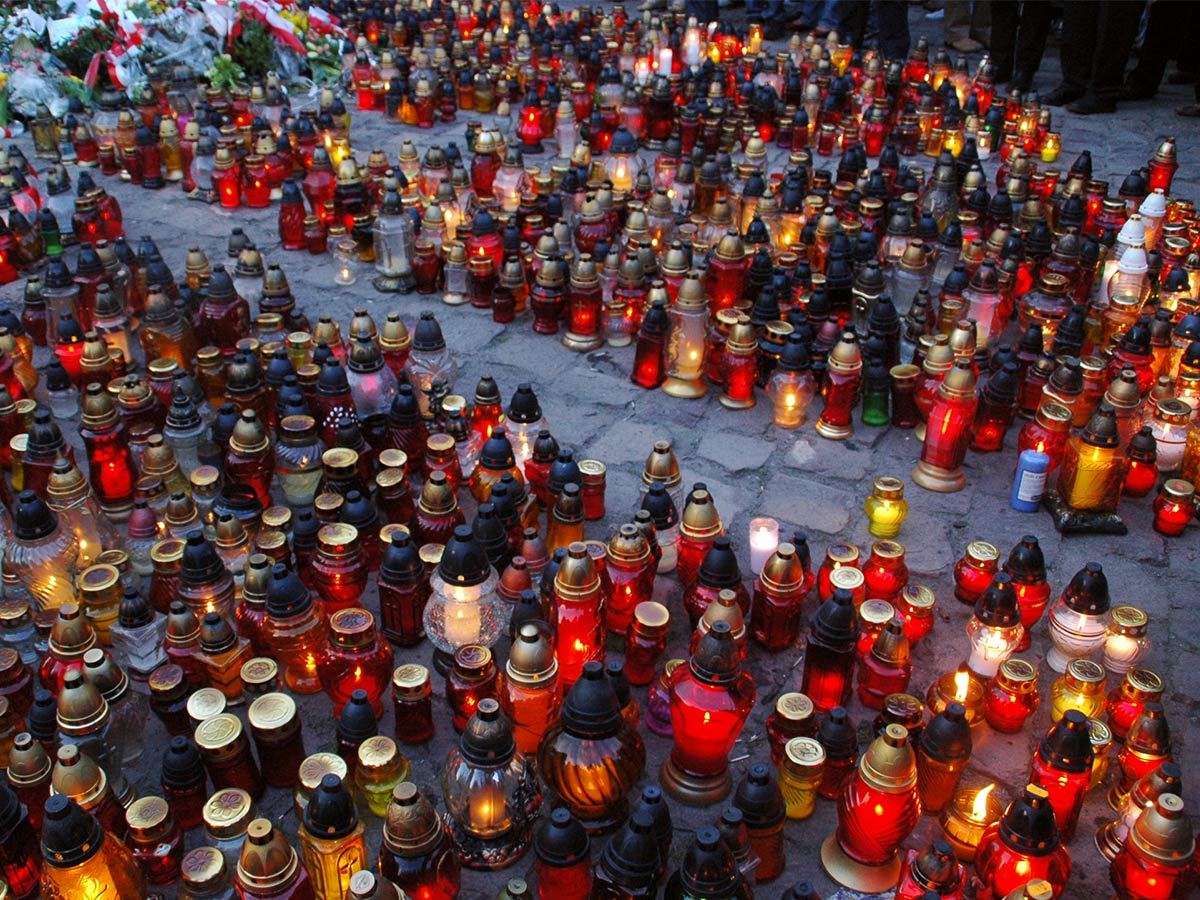
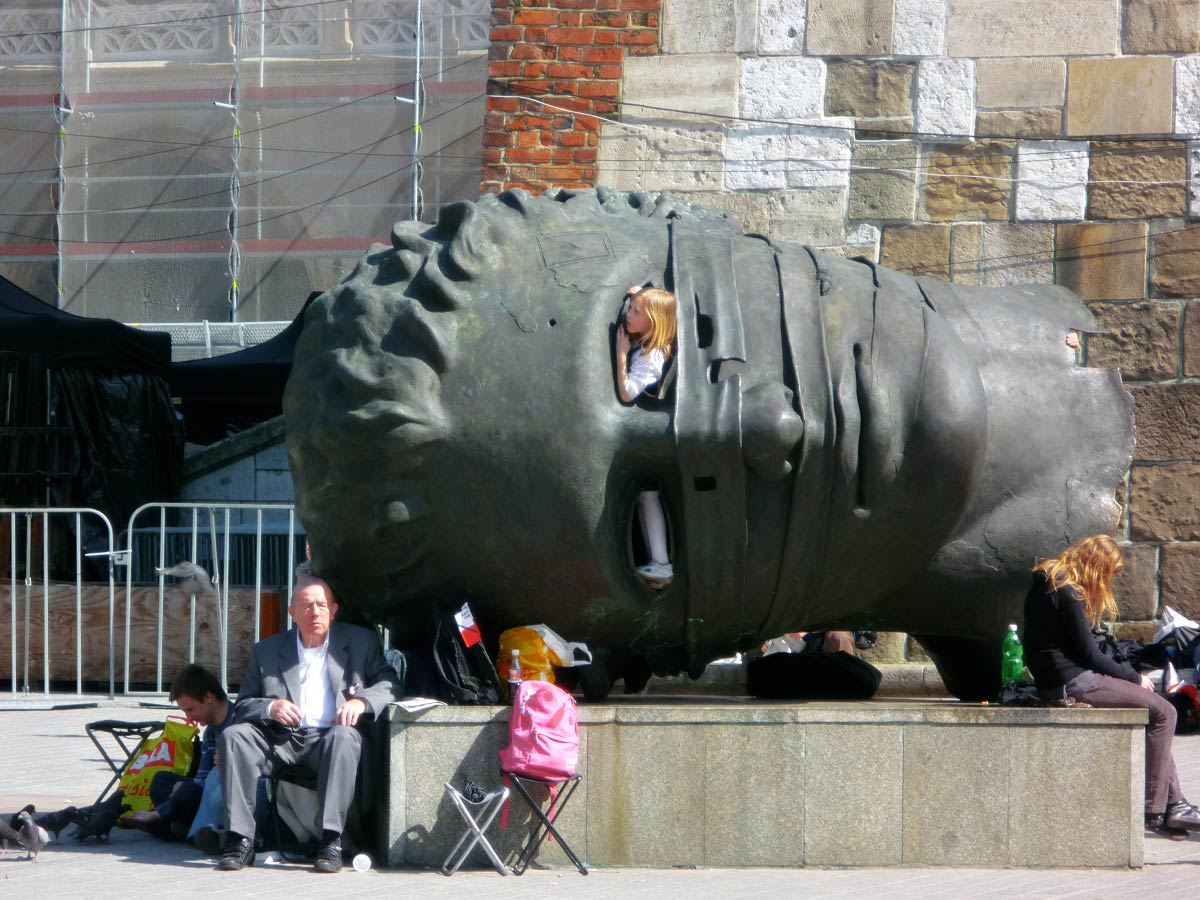
Along with the giant TV monitors and speakers set up throughout the Main Square, posters of the crash victims adorned the square. Groups waved banners that read: Katyn.
Some people cried, some feverishly waved flags, some shook their heads.
Onlookers from all ages took it all in, held their rosaries and said prayers. People hugged, touched hands.
This is what a country in mourning looked like. They were together in their demand for answers, their sorrow. Somber but together.
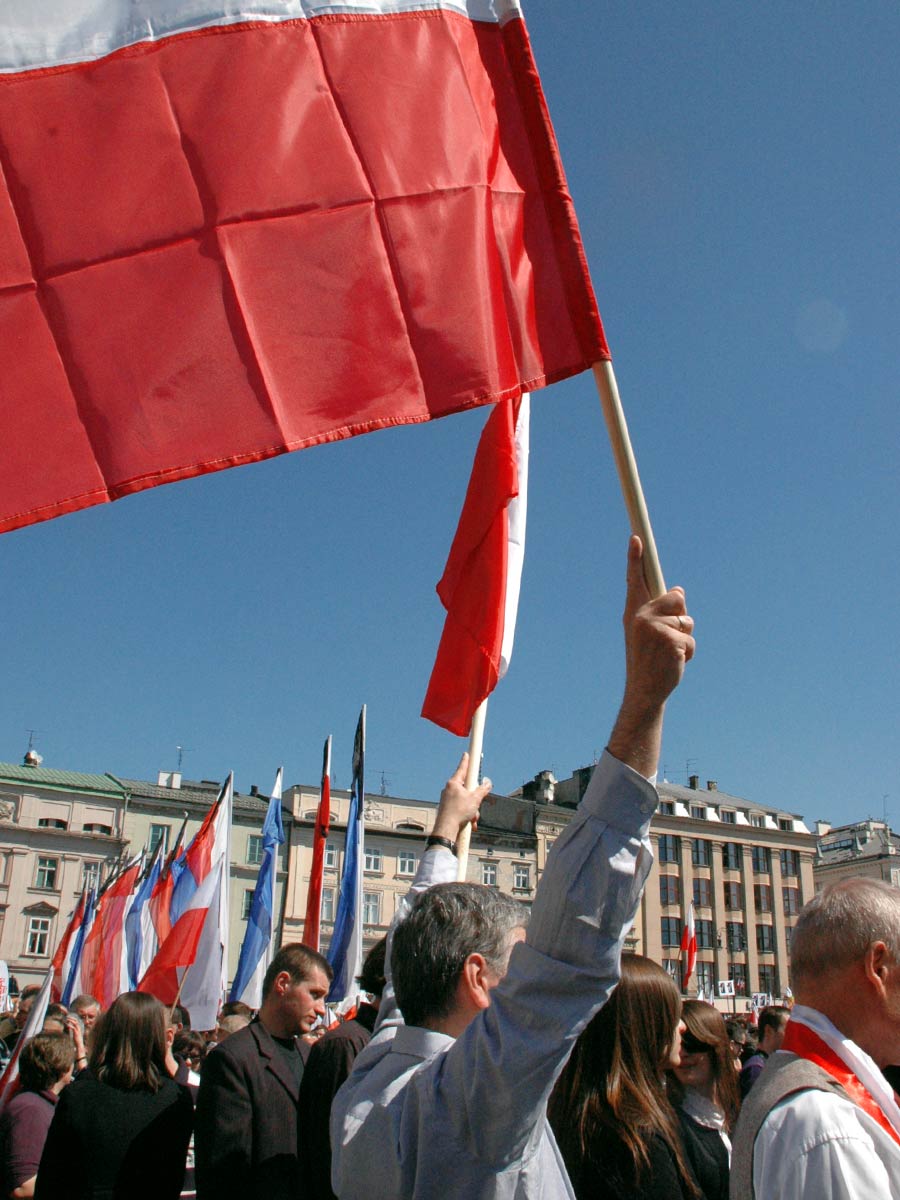
Even as I write this in 2020, just shy of 10 years later, I can’t help but wonder what such a gigantic loss would look like in America today. A nation so divided, I’d hope in the rawness of loss we’d still be able to band together like the people of Krakow.
In time, the plane crash would be blamed on improper training and communication causing several high-ranking Polish military officers to resign under intense pressure from politicians and the media.
As we boarded the train back to Prague, I couldn’t help but try to sift through all the emotions the past few days had brought me.
Many leave Krakow with visions of a historic, quaint city and with colorful old buildings where horse-drawn carriages clunk down the cobblestone allies.
But I left with something much deeper. An outsider’s look into a country balancing their brokenness and healing, their past and present. I was a witness to sobering scenes of present despair and a haunting glance into a brutal past. But I was also a witness to acceptance, togetherness and perseverance.
This was the core of why I wanted to be a journalist. To bear witness to the human experience and share it with others.
Tomorrow, we remember those lives lost at Auschwitz by commemorating the camp’s liberation 75 years ago. And in a few months we will remember those lives lost on the 10th Anniversary of the Smolensk Air Disaster. A group of lives lost while attempting to commemorate a different wound from their past.
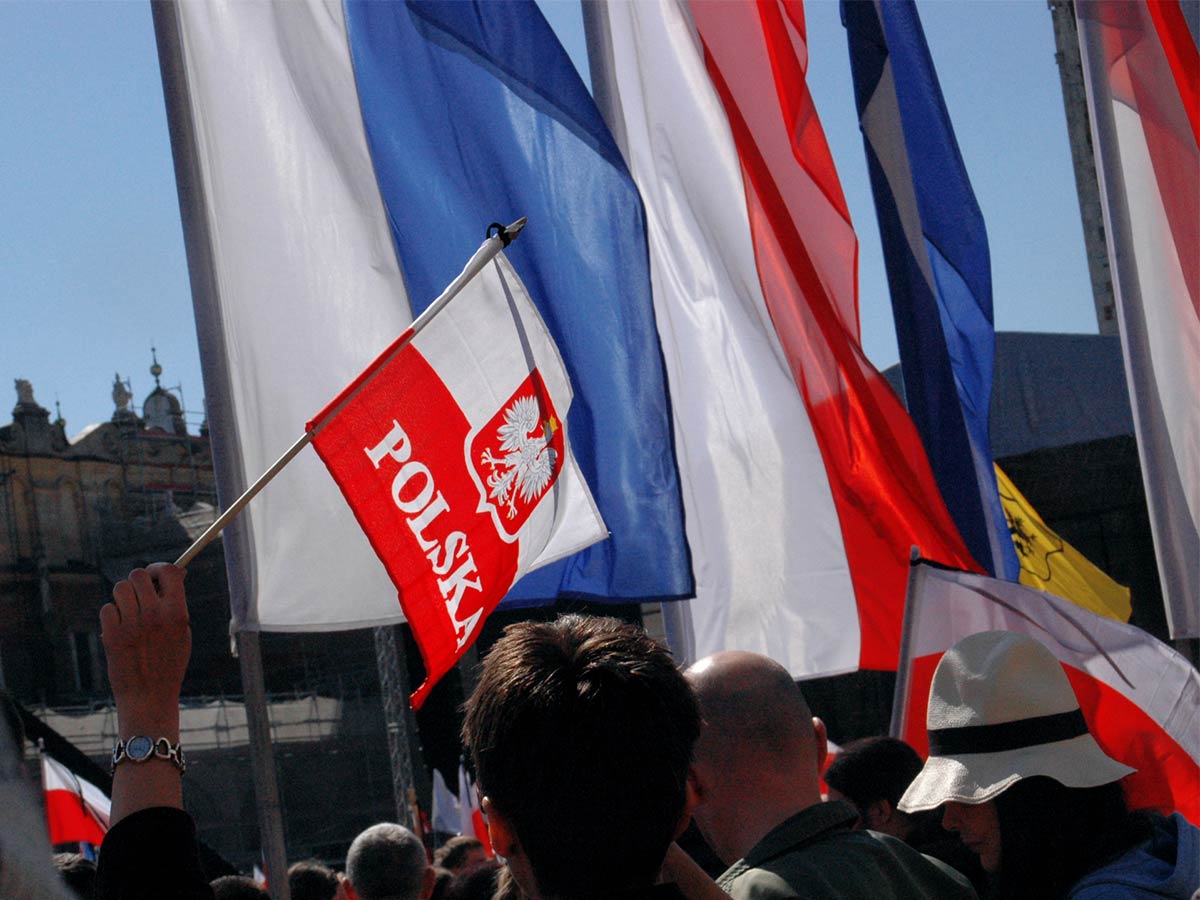
Sources:
